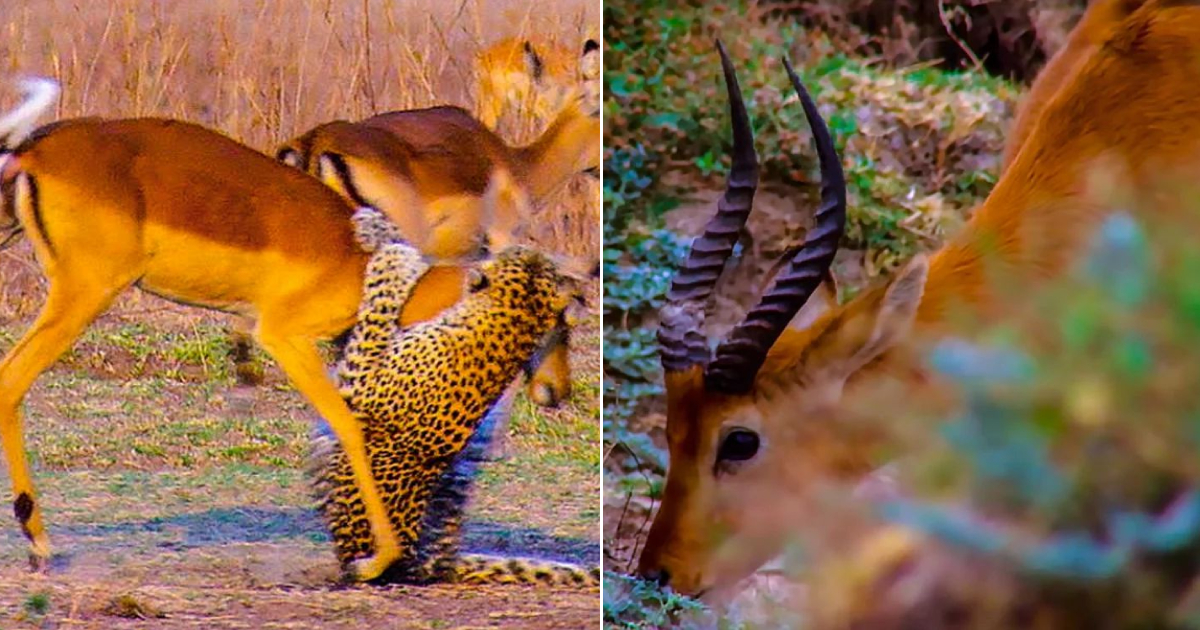Miraculous Escape of an Antelope from the Jaws and Claws of a Leopard

Large cats behave similarly to our beloved pets, but in their world, everything is a little bigger, including their prey. The leopard decided to take advantage of not only its innate sense of skilled hunting, but also the exceptionally convenient terrain.

Stealthily, it crept into a natural hollow. Its prey was above, completely unaware of the danger. With each careful movement, the leopard got closer and closer to the antelopes.
These adorable creatures, known as black-faced impalas, grazed, lifting their heads for a moment to look around. Once they deemed it safe, they continued nibbling on grass and shifting from one leg to the other.
There were only ten meters left until the prey. The leopard kept moving, trying to stay as close to the ground as possible without revealing its presence.
Unexpectedly, from around the corner of the hollow, the head of an impala appeared. One animal wanted to try the vegetation in the valley. This antelope managed to survey the surroundings and chew on the grass almost simultaneously. The predator had no chance of moving forward.
The leopard froze for a moment, its paw suspended mid-air, and its heart, if possible, slowed its beats to a minimum.
The predator prepared to attack, not wanting to disrupt the silence of the moment and reveal its presence.
But something disturbed the antelopes. Several of them abruptly burst out to the surface. The entire prey scattered. To save themselves, all they needed to do was run, fast and far.
The leopard seized the first opportunity unsuccessfully. Surrendering now would result in a failed hunt, leaving the hunter hungry. While not all the prey had decided to save their lives yet, the leopard made the decision to climb out of the pit.
It carefully raised its head and, with its gaze scanning all the remaining animals, selected its target – one impala that would sacrifice itself to satisfy this cat’s hunger.
Mistakes were no longer acceptable. The leopard attempted to get as close to the prey as possible. Slightly accelerating, it headed towards the edge where several antelopes had gathered.
Relying not only on its instincts but also on its sight, the leopard, pausing for a moment, lunged at the prey from the pit. With a swift start, this fast feline, capable of running at speeds of 60 km/h, left the grazing antelopes no chance to react.
All the prey would attempt to escape from the predator, but even innate self-preservation instincts were insufficient when the leopard decided to bring the hunt to its logical conclusion. For the second time, the prey would be caught.
Just a few leaps and the final pounce. The leopard’s paws wrapped around the impala, and its neck ended up in its jaws. The beautiful and lively animal transformed into a trophy, effortlessly dragged underground by the big cat, disappearing again into the ominous hollow.
After such a success, proving the superiority of strength and skill over a peaceful and tranquil life, tears well up in one’s eyes. Despite the preparation and understanding that the hunt always ends badly for one side, scenes like these evoke pain and sympathy again and again.
The antelope was still very young, but its youth did not protect it.
Unwilling to believe what had happened, one’s gaze cannot be diverted, perhaps hoping that something else could happen or a miracle would occur, if they still occur at all. And what is this?
In some inexplicable way, the motionless creature from just a moment ago comes back to life right before our eyes. Unable to believe its luck and shocked by what is happening, the antelope escapes from the clutches of death.
It trembles all over, staggering from side to side, but alive and, surprisingly, unharmed, the antelope rushes away from its own demise.
The second birth was terrible, but the realization of the reality of the threat may grant this individual a greater sense of caution, thus making it impossible for any predator to ever catch it. However, no one knows this, just as no one knows where to find a straw to rest upon.











